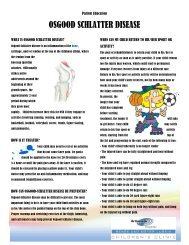“It's A Bargain” Thrift Shop - Orthopaedic Hospital
“It's A Bargain” Thrift Shop - Orthopaedic Hospital
“It's A Bargain” Thrift Shop - Orthopaedic Hospital
You also want an ePaper? Increase the reach of your titles
YUMPU automatically turns print PDFs into web optimized ePapers that Google loves.
18<br />
ogy, Diabetes and Metabolism.<br />
He was the program director of<br />
the General Clinical Research<br />
Center at Cedars-Sinai’s Burns<br />
and Allen Research Institute.<br />
He is a professor of medicine in<br />
residence at the David Geffen<br />
School of Medicine.<br />
Dr. Adams received his<br />
bachelor’s degree from the University<br />
of Kansas and his medical<br />
degree from the University<br />
of Kansas School of Medicine.<br />
He completed his fellowship<br />
in endocrinology and internal<br />
medicine at Massachusetts General <strong>Hospital</strong>, Harvard<br />
Medical School.<br />
In the following interview, Dr. Adams outlines<br />
his vision for the Orthopædic <strong>Hospital</strong><br />
Research Center.<br />
motion: <strong>Orthopaedic</strong> research seems poised to<br />
achieve breakthroughs in the coming decade,<br />
perhaps even eliminating the need for surgery<br />
in some cases.<br />
Dr. Adams: That’s true. First, you want to try to<br />
prevent illnesses or fractures before they occur.<br />
Second, if you do have to repair something, it<br />
would be a lot better if you could do it in the<br />
cells and matrices instead of performing surgery.<br />
Our view is that the major advances in<br />
medicine over the next 50 to 75 years will<br />
be made by teams of scientists that normally<br />
wouldn’t be positioned to work together.<br />
Consider fractures that occur due to osteoporosis.<br />
Osteoporosis is a major political and<br />
social healthcare problem. It’s expensive. It<br />
causes a tremendous amount of suffering for the<br />
individual who sustains a fracture and for the<br />
family who must deal with this person who can<br />
no longer live independently.<br />
The major cause of morbidity and mortality<br />
in this disease is age. Once you fracture your<br />
hip, you’re never really the same. If you’re a man<br />
over 80, you have about a 50% chance of dying<br />
in the first year after surgery.<br />
These are big medical problems that affect a<br />
huge number of people. Right now, we’re wait-<br />
research<br />
“Our view is that the major<br />
advances in medicine over the<br />
next 50 to 75 years will be<br />
made by teams of scientists that<br />
normally wouldn’t be positioned<br />
to work together.”<br />
— John S. Adams, MD<br />
Vice Chair for Research,<br />
UCLA and Orthopædic<br />
<strong>Hospital</strong> Department of<br />
<strong>Orthopaedic</strong> Surgery<br />
ing for the fracture to occur, we’re fixing it and<br />
we’re keeping our fingers crossed that the person<br />
doesn’t fall again and experience another<br />
fracture.<br />
But we are really getting a grasp on how to<br />
best handle these orthopaedic conditions.<br />
In osteoporosis, the major determinant of<br />
bone mass — which is the major determinant<br />
of fractures — is how much bone you start off<br />
with at the end of adolescence. It’s not the way<br />
in which you lose bone but actually where you<br />
are at peak bone mass, which is at 19 to 20<br />
years of age in females and males, respectively.<br />
Everybody loses bone mass after the age of<br />
25. Because women start with about 20% less<br />
bone than men, they get to the fracture threshold<br />
more quickly. Now that men are living<br />
longer, they’re having exactly the same thing<br />
occur to them, except that it’s about 10 years<br />
later because they started off with more bone<br />
to begin with.<br />
motion: Can we do anything to improve peak<br />
bone mass?<br />
Dr. Adams: What’s interesting is that 85% of the<br />
variation in peak bone mass is genetically determined.<br />
85%! So that means whether you will or<br />
will not get osteoporosis is pretty much determined<br />
at the time of conception. We’re making<br />
a big push to find the genes that are responsible.<br />
We want to know how they get turned on during<br />
adolescence and how they are responsible<br />
for the construction of the mature skeleton.



